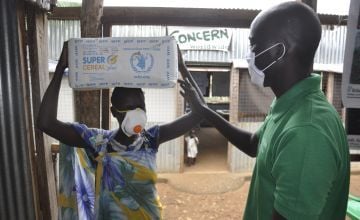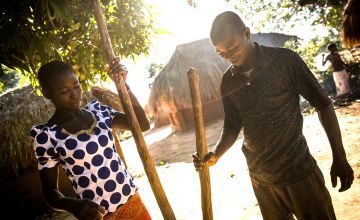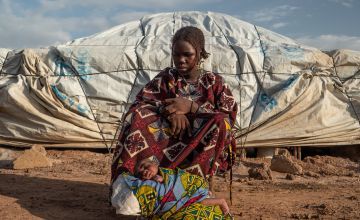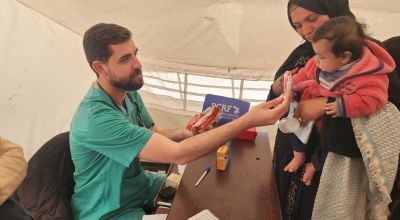
Knowledge Hub
Forgotten crises: three global emergencies you should know about

Many global events do not make the front page of the media. This does not mean they are not happening; or that we are not there responding. Here are three global emergencies happening right now that you should know about.
Hunger in the Democratic Republic of Congo
For decades, one of the world’s deadliest, longest-running crises has been unfolding in the Democratic Republic of Congo (DRC). Yet you’ve probably heard almost nothing about it.
The DRC is home to nearly 13 million people requiring humanitarian assistance. Moving from the national conflict of the late 1990s, a series of smaller, localised conflicts have erupted focused on specific regions and centred on land, resources, and power. On a continent that has the most displaced people in the world, the DRC has nearly 5.5 million people away from home, representing the third-largest population of internally displaced people (IDPs) in the world. This ongoing conflict directly relates to the DRC’s high levels of hunger, large-scale population displacement, low household purchasing power, and agricultural hardships.

However, even in parts of the country where violence has ceased, livelihoods and access to food have been destroyed. Any stability that comes with a ceasefire will be short-lived if people are unable to recover their lives. Covid-19 also had a significant impact on food prices, and country-wide economic decline has decreased the purchasing power of households. The DRC is now the biggest food security crisis in the world, with over 27 million people facing severe or acute food insecurity.
We are pushing to get to where the greatest needs are faster, for example by setting up a mobile Rapid Response teams to respond to recent displacements across the country.
In 2021, through our livelihoods programme following a graduation approach in the DRC, over 34,500 people in 22 villages benefitted from activities including cash for work, setting up savings and loans groups and water and sanitation projects to improve health. Given the current context, we focussed particularly on activities aiming to reduce food insecurity. The programme supported participants by distributing seeds and setting up Farmer Field and Life Schools to support food production. We also carried out practical cooking demonstration sessions on food diversification to increase household dietary diversity and carried out an emergency food distribution in villages affected by the destruction of fields by elephants.

Climate crisis in Somalia

One of the most extreme droughts in recent history has left East Africa on the verge of a humanitarian catastrophe. Somalia, located in what is also known as the Horn of Africa is one country particularly affected. In Somalia, a severe drought is causing the number of people needing urgent humanitarian assistance to escalate rapidly. The number of people affected by drought has risen from 4.9 million in March to about 6.1 million in April.
Displacement in Somalia is also rife due to conflict, insecurity, drought, and flooding. An estimated 1 million people have been displaced in Somalia, of which 2 million are children. In April 2022 alone, over 25,000 people were displaced by drought, and in March 7,000 people were internally displaced by conflict.
Consequently, as of 20 April, six areas in Somalia are facing the risk of famine in the coming months. Without sustained humanitarian assistance, more than 6 million people are facing severe to near-complete food shortages between now and June.
We’ve launched an emergency appeal for East Africa, which is experiencing one of its most severe droughts in recent history to help provide life-saving emergency food to children. More than 23 million people are facing dangerous levels of hunger in Ethiopia, Kenya, and Somalia across the region.
We are already fighting to prevent the situation from getting worse by treating tens of thousands of people suffering from severe malnutrition, providing emergency water and cash to buy food, repairing boreholes and wells, and vaccinating livestock against disease. But more is needed to prevent the starvation of millions.
Conflict in Burkina Faso

Political unrest, conflict and climate change have combined to form an unprecedented humanitarian emergency in a country that already struggled with chronic hunger and malnutrition. Conflict has displaced more than 1.9 million people in just two years, making Burkina Faso one of the fastest-growing displacement crises in recent times. 80% of all internally displaced Burkinabés are women and children. More broadly, one-fifth of the country’s population, or 3.5 million Burkinabés, require humanitarian assistance; a 60% increase in the last year. Burkina Faso also has one of the highest child mortality rates in the world.
We are working hard to meet the main needs to help people living in Burkina Faso, including food security, nutrition, water, sanitation and hygiene, and health. So far:
- Over 350 households have received emergency assistance to cover their basic food and shelter needs after fleeing armed conflict in the East and Sahel regions
- We have worked with health centres and community health workers in the Pouytenga health district to provide improved health and nutritional services to over 50 000 people, including displaced families
- We have provided 1000 basic hygiene and dignity kits to displaced people to limit their risk of illness and improve living conditions.
We deliver life-saving and life-changing interventions to some of the world's poorest and most vulnerable people. From rapid emergency response to our innovative programming in health and nutrition, livelihoods and education, we go to the hardest to reach places to make sure that no-one is left behind.
Your donation makes a difference
Other ways to help
Donate now
Give a one-off, or a monthly, donation today.
Join an event
From mountain trekking to marathon running, join us for one of our many exciting outdoor events!
Buy a gift
With an extensive range of alternative gifts, we have something to suit everybody.
Leave a gift in your will
Leave the world a better place with a life-changing legacy.
Become a corporate supporter
We partner with a range of organisations that share our passion and the results have been fantastic.
Create your own fundraising event
Raise money for Concern by organising your own charity fundraising event.




